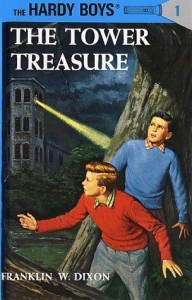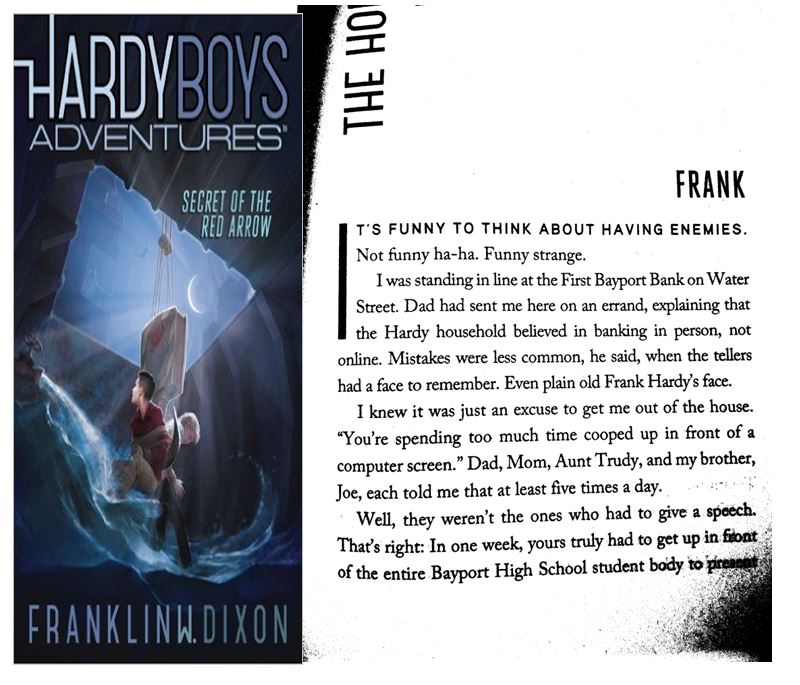I grew up with the The Hardy Boys. The writing was crisp and the stories were heart-pounding (to a 10-year-old). At the time there were about 40 titles in the series, and I think I read every one of them. I owned a few titles, traded others with friends, and borrowed the rest from the library.
 I outgrew Frank and Joe’s adventures, but generations of new readers kept them alive. Eventually the series grew to 190 titles. There was even a version for elementary school students, the “Clues Brothers”.
I outgrew Frank and Joe’s adventures, but generations of new readers kept them alive. Eventually the series grew to 190 titles. There was even a version for elementary school students, the “Clues Brothers”.
When I started tutoring with the Community Reading Project, I was delighted to find a new series of stories – the ‘Undercover Brothers’. Frank and Joe were now undercover agents, hunting down murderous criminals with high-tech gadgets. The books were inexpensive, fast-paced, and well-written, every chapter was a cliff-hanger with Frank and Joe alternating first-person narrative. I recommend them for emerging readers (boys, anyhow).
The first two Hardy Boys titles that Haroun and I read together came from the ‘Undercover Brothers’ series – “Burned” about a CD counterfeiting ring, and “Top Ten Ways to Die” about a pop star that somebody wanted dead. We raced through them gleefully – reading aloud alternate-pages until Haroun was exhausted. Sometimes I had to continue reading to him because we just couldn’t put the book down at that point.
There is now a newer series called ‘Hardy Boys Adventures’, and Haroun and I have just finished the first title “Secret of the Red Arrow”. Terribly written. Painful to read. A plot so weak that it might as well be missing. . No one will develop a love of reading from these dreadful, awful books.
The rest of this posting is about what makes a book easier or harder for a struggling reader in the context of an intensive intervention, illustrated by some of the books I use.
Goosebumps
I love Goosebumps books, especially the ‘HorrorLand’ series. They are written for grade-3 readers and perfect as first books for severely reading-impaired teen-agers. They are full of whimsy and humour, and the stories are engaging. They can be read from chapter to chapter without following the longer story, and they are delightful.
Below is the first page of a typical one. The first thing you will notice is the short punchy paragraphs and short sentences with straight-forward structures. Read it aloud, and feel how it flows. It is almost effortless to place the story and put yourself into it.
The vocabulary isn’t simple, with mosquitoes and orangutans, but it is mostly concrete nouns, action verbs, mostly in present tense, and the dialog is direct and simple. There is a challenging rhetorical question on this page, but in a form that emerging readers might understand (they are rare in the book).
The chapters are short enough that a struggling reader can engage in retelling and ‘key idea’ analysis.
Hardy Boys ‘Undercover Brothers’
These books are considered grade-4 books. They follow a strict formula: Frank and Joe alternate narration, and every chapter ends in a cliff-hanger. They are traditional detective mysteries, with multiple suspects and red herrings, but they are also adventure stories.
Below is the first page of a typical one. The vocabulary is only a bit harder than Goosebumps, but look at the sentence structures. There are compound, complex, and independent clauses. Dialogs that are more formal than normal speech. This is great stuff for a reader who is confident enough to attack it.
Again, read the page aloud. The short sentences move the story along. For a struggling reader, they provide frequent rest-stops to monitor comprehension. It’s harder to figure out where the Hardy Boys are and what they are doing, and we hear strange expressions like ‘eat snow’, but there are lots of clues to help. This text will help an emerging reader grow.
One of the trademarks of this excellent series is the friendly banter traded by the high-school brothers, teasing each other about girlfriends, teachers, schoolwork, and such. I read these with middle-school students, and they pay close attention.
Hardy Boys Adventures
This is the newest incarnation of the Hardy Boys. In some ways it follows the previous series: Frank and Joe alternate narration and every chapter is a cliff-hanger. But these are neither mysteries nor adventures. If the ‘Secret of the Red Arrow’ is any measure, they are merely awful, boring, pointless books.
The cover of ‘Secret of the Red Arrow’ says “ages 8-12”, but the poor writing makes reading too difficult for emerging readers. The first page (below) is a good example. Lengthy dead paragraphs piled with digressions on top of digressions. Extra factoids – ‘standing in line at the First Bayport Bank on Water Street’ instead of ‘standing in line at the bank’. A mix of present, future, and multiple past tenses. Old-fashioned expressions like ‘yours truly’ instead of ‘me’.
Imagine that you struggle to read. Your decoding is slow, effortful, and error-prone, you must continually monitor your understanding. And then you run into that long blather about banking in person and mistakes and tellers and plain faces. Haroun had me hovering over him to ‘auto-correct’ and to re-read these complex sentences but it was still hard for him. I should have abandoned this horrible book at the second paragraph.
Sometimes extra facts are ‘foreshadowing’, a signal to the reader to pay attention to a detail that will be required later. Foreshadowing is suitable for more advanced readers who can follow a lengthy narrative. Extra facts are littered everywhere in this book, but having painfully read to the end I can assure you NONE of them foreshadows anything. There are no clues, no motives to unravel. It’s just literary litter.
The vocabulary on the first page isn’t particularly difficult, but here’s a sentence from the interior of the book: “I could tell that, in Frank’s estimation, it wasn’t exactly outside Pett’s wheelhouse to cause somebody bodily harm.” Really? Just as bad, the book is filled with cultural references that young readers will not understand. Beatniks? Karmann-Ghia? Quentin Tarantino? Catch-22?
I wish I could say that the plot rescues the writing, but sadly not. Actually, there is no plot. There are some implausible things that happen (which is ok), but they are not tied together in any sensible way and only explained as ‘done by someone with connections’. The characters are never developed, conflicts are never explained or resolved, and motives are never explored.
The only good that came from the eight days we wasted reading this awful dreck was Haroun’s practice on breaking and sounding multi-syllable words with Latin roots, like exceptional, procrastinator, notorious, impressive, accidentally (all found on page 2). By the end he was quite expert.
Stay away from these dreadful books.






Leave a Reply